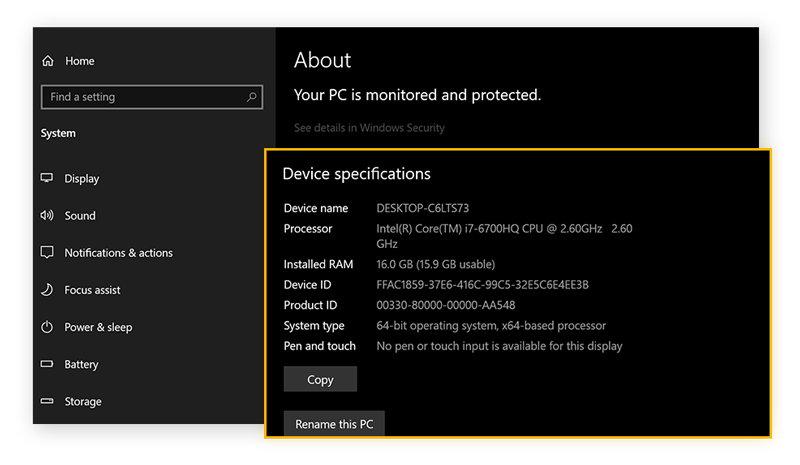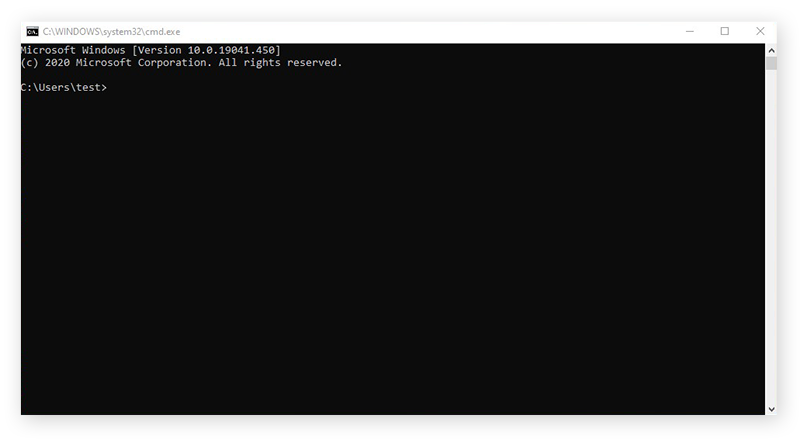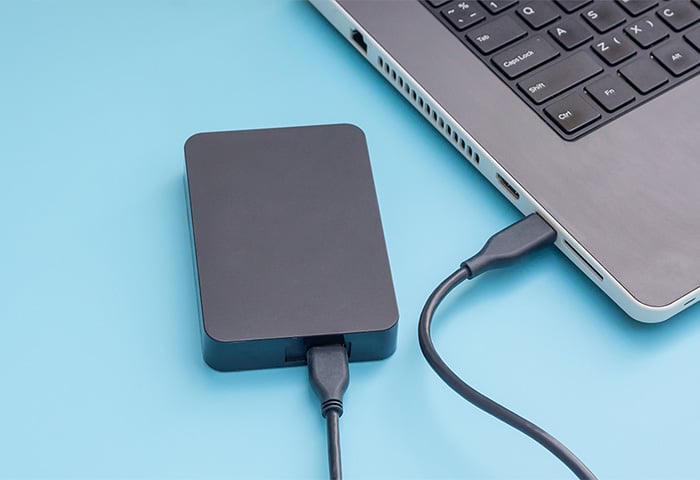Essential computer specs
There’s a lot of information you can learn about what's inside your computer, but in most cases, you’ll be interested in one of the key specs listed here.
If you already know which spec you’re interested in and want to quickly learn how to check its details, hop down below.
CPU
The CPU (central processing unit) is your computer’s brain. Many programs need a CPU with a minimum level of processing power, so you’ll want to know exactly what your computer can handle. An overworked CPU can easily overheat, so it’s good to monitor your CPU temperature, especially when putting it under heavy stress.
GPU
Your GPU (or graphics processing unit) handles everything you see on your screen. Knowing your GPU specs is especially important for gaming and other graphics-intensive tasks like video editing. Just like your CPU, your GPU can also overheat if you give it more than it can handle.
RAM
Your computer uses RAM (random access memory) to juggle all its active tasks at any given moment. The more RAM you have, the more your computer can handle — the more tasks it can process — at once.
Motherboard
Your CPU, GPU, and RAM all connect to the motherboard, which lets them communicate with one another. Since it’s a piece of hardware, the motherboard has certain physical limits — for example, if your motherboard has only two RAM slots, you won’t be able to install more than two RAM modules if you’re upgrading your RAM.
Hard drive space
Whenever you’re installing a new program, it’ll tell you how much space in the hard drive it needs. If you don’t have enough, you won’t be able to install it. The same goes for downloading or creating new files.
Why should I check my PC specs?
Understanding the hardware inside your PC can help you with a number of tasks and in a variety of situations. Here are a few examples of when it would be good to know how to check your RAM, your CPU, and your other computer specs:
-
When you’re selling your PC: When selling your computer, list all its specs together. This will give potential buyers the info they need to make an informed decision, and it will also help you figure out how much you should charge.
-
When you want to buy a new PC: Looking at your current specs can help you figure out what you need in a new computer. Learning where your current machine falls short will help you determine how powerful your new computer should be. If you’re building your own machine, you can compare CPU specs and look at different GPU benchmarks to decide what you need.
-
When you need support: Got a hardware or other performance issue? When contacting tech support, be ready to give them the relevant specs for your issue. To give you the best advice, they’ll need to know what you’re working with.
-
When you’re updating your drivers: You’ll need to know the exact model number of your graphics or sound card when you update your graphics drivers or update your audio drivers. That is, of course, unless you’re using an automated driver updater.
AVG Driver Updater will detect your hardware specs and keep all your drivers updated automatically. Its super intuitive interface will help you update your outdated or faulty drivers, fix any lingering driver-related issues, and get your computer back to optimal performance in no time.
-
When you want to try a new game or app: Got an older PC or laptop and want to play the latest game — or even a classic like GTA 5 or Ark: Survival Evolved? First, make sure your computer meets the game’s minimum requirements. If not, you won’t be able to install it.
-
If you’re overclocking your CPU or GPU: Overclocking your CPU or GPU means tuning it so that it runs faster than it otherwise would with its default settings. Before you start, check your specs and stress-test your CPU or GPU so that you know your starting point. CPU and GPU overclocking can be a bit risky, so you’ll want to gather as much info as you can before you start.
No matter what you’re doing, keep reading our guide for Windows 10, 8, and 7 to learn how to check out all your PC’s hardware specifications, such as installed memory, system summaries, and details about your operating system.
How and where to check your CPU, RAM, motherboard, and GPU specs
Windows gives you a few ways to find your hardware specs. Depending on the level of detail you need, try one of the following methods for how to check your CPU specs and find out other information.
Check your computer specs using Windows system settings
Your Windows system settings provide an easy and convenient way to check your computer specs. First, we’ll show you how to do this on Windows 10, then we’ll go through it on Windows 7.
Opening Windows system settings in Windows 10
Click Start, open your Settings, and go to System. Select About from the menu on the left.
 This will show you your basic PC specifications and which version of Windows you have installed.
This will show you your basic PC specifications and which version of Windows you have installed.
 You can easily copy and paste your specs right from this screen.
You can easily copy and paste your specs right from this screen.
Opening Windows system settings in Windows 7
Right-click on the Computer icon and select Properties.
 Here you’ll see a basic list of specs, such as your processor, available RAM, some support numbers (depending on the PC manufacturer), and which version of Windows you’re running. The details you’ll find here aren’t super extensive, but they’ll work.
Here you’ll see a basic list of specs, such as your processor, available RAM, some support numbers (depending on the PC manufacturer), and which version of Windows you’re running. The details you’ll find here aren’t super extensive, but they’ll work.
 If you need more information, click on Device Manager on the left side of the screen and go through individual devices (more on that below).
If you need more information, click on Device Manager on the left side of the screen and go through individual devices (more on that below).

Check computer specs using the Command Prompt
Put on your (helpful) hacker hat and type Windows + R to bring up your computer’s Run window. Enter cmd and press Enter to open the Command Prompt window.
 Type the command line systeminfo and press Enter. Your computer will show you all the specs for your system — just scroll through the results to find what you need.
Type the command line systeminfo and press Enter. Your computer will show you all the specs for your system — just scroll through the results to find what you need.

Check computer specs using the Device Manager
Need to figure out the exact name of a specific device, such as your graphics card or sound chip? Device Manager is the way to go.
Right-click on your Windows menu and select Device Manager.
 The next window that opens will show you a list of everything that’s built into your PC or laptop. Go through each item on the list and check the device names, as shown in the screenshot below.
The next window that opens will show you a list of everything that’s built into your PC or laptop. Go through each item on the list and check the device names, as shown in the screenshot below.

Device Manager usually gives clear and full names for each accessory or device connected to or built into your PC or laptop.
Still not sure what a specific device is? Does the listing say Unknown? Don’t worry. You can still figure out the device’s GUID (Globally Unique Identifier). This is a string of numbers that will help you identify what device you’re looking at.
Double-click on the mysterious entry in Device Manager, such as Broadcom 802.11ac. Then, go to Details. Under Properties, select Hardware Ids. Right-click on one of the entries, copy it, and head over to your favorite search engine to learn more about it.

With a quick internet search, you can easily find the exact name of the unknown device.
Check detailed computer specs using System Information
Let’s dive a bit deeper. The best and most thorough built-in tool for checking your PC specs is System Information. To open it, click on your Windows menu and begin typing the phrase System Information. Windows will find it for you.

Click System Information (or hit Enter). The tool that opens next is the most complete, but also the most complex, way to figure out your PC specs. You can find anything from your computer’s BIOS/UEFI version, to your motherboard’s revision number, to all the drivers and applications running on your machine.
It doesn’t get more detailed than that!

You can use this tool to:
-
Search for specific information. Use the Find what field at the bottom of the window to look for anything, such as graphics cards or USB ports.
-
Generate a system report: Open the File menu and click Export to save all this information into a handy text file for sharing. This can be useful when a support person is asking you for these details, or when you need to share your hardware specifications on an online forum.
Use a third-party tool to easily view all your specs
Windows’s built-in spec-hunting tools can be a bit tricky to navigate. And with so much information, it’s hard to know exactly where to look. If you’re feeling overwhelmed, consider a specialized spec-checking tool.
Speccy is a free tool that conveniently displays your computer specs, letting you easily and quickly find the info you need.

Get the best performance from your existing hardware
By using Windows’s built-in tools or a free third-party tool like Speccy, you can easily find all the specs inside your PC. Whether you’re looking for information about your RAM or CPU, or if you just want to know which programs are installed on your PC, these tools will help you find all your computer specs.
To get the most out of the hardware under your PC’s hood, and to unclog annoying performance bottlenecks, make sure your computer gets regular maintenance and tuning. AVG TuneUp cleans out unwanted junk, keeps your files organized, and monitors resource usage to ensure optimal performance at all times.

 This will show you your basic PC specifications and which version of Windows you have installed.
This will show you your basic PC specifications and which version of Windows you have installed. You can easily copy and paste your specs right from this screen.
You can easily copy and paste your specs right from this screen. Here you’ll see a basic list of specs, such as your processor, available RAM, some support numbers (depending on the PC manufacturer), and which version of Windows you’re running. The details you’ll find here aren’t super extensive, but they’ll work.
Here you’ll see a basic list of specs, such as your processor, available RAM, some support numbers (depending on the PC manufacturer), and which version of Windows you’re running. The details you’ll find here aren’t super extensive, but they’ll work. If you need more information, click on Device Manager on the left side of the screen and go through individual devices (
If you need more information, click on Device Manager on the left side of the screen and go through individual devices (
 Type the command line systeminfo and press Enter. Your computer will show you all the specs for your system — just scroll through the results to find what you need.
Type the command line systeminfo and press Enter. Your computer will show you all the specs for your system — just scroll through the results to find what you need.
 The next window that opens will show you a list of everything that’s built into your PC or laptop. Go through each item on the list and check the device names, as shown in the screenshot below.
The next window that opens will show you a list of everything that’s built into your PC or laptop. Go through each item on the list and check the device names, as shown in the screenshot below.









/Signal-How-to-scan-and-fix-hard-drives-with-CHKDSK-in-Windows-Thumb.jpg)








